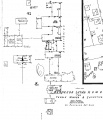Lutheran Home for Feeble Minded and Epileptics
| Lutheran Home for Feeble Minded and Epileptics | |
|---|---|
 | |
| Established | 1903 |
| Opened | 1904 |
| Current Status | Active |
| Building Style | Single Building |
| Location | Watertown, WI |
| Alternate Names |
|
History
On April 13, 1904, Bethesda opened its doors in a rented building on Margaret Street and was called The Faith House. There were five clients and eight staff members. The Faith Home was unable to renew its lease and moved to Milwaukee for three years. In 1909, the facility moved back to Watertown and relocated to new quarters constructed on 40 acres of donated land. It offered jobs and training to the people they supported. Some early jobs included basket weaving and rug making. When more land was added the facility began farming and raising their own food. In 1907 due to overcrowded conditions and a long waiting list, Bethesda built the first building on the 40 acres of land that was donated in 1903. Back in Watertown, Wis. individuals who received support and services helped with the farming, gardening, and tending of livestock while also helping to take care of those less able.
During the depression of the 1930s, Bethesda sold wool batts and thistle tea to raise money. Of the 368 people living at Bethesda, 245 received no financial support. Money was a problem, so the staff took a pay cut. Then God blessed Bethesda with two bequests and numerous other contributions, making the building of a new chapel possible.
By 1956, A notable milestone in the history of the Bethesda Lutheran Home took place when ground breaking ceremonies were held for two new buildings - a hospital or adult building and a school. The cost of the two units will be $2,000,000. The new facilities would enable the institution to handle 750 patients, the old facility had a capacity of 300. The first shovel of dirt for the new adult or hospital building was turned by Louis Pingel, who until his retirement has been superintendent of the institution for nearly 30 years, whose long range planning has included the present building program.
In 1980 three buildings at Bethesda Lutheran Home have been demolished to make room for a parking lot. The oldest unit, the Eggers building, was erected in 1909 for a cost of $35,000. The second section of the Eggers building was constructed in 1913. In 1922 the Tetzlaff building, part of a $175,000 building project, was put up. It was connected to the Eggers building by a long corridor which after remodeling to the front and rear became the Prange building. In recent years it housed administrative offices which have been moved to the remodeled Pingel School building. None of the demolished units met state fire codes and residents hadn't lived there for three to four years. Besides tearing down the three buildings, the back wall of the chapel, which was the front wall of the Tetzlaff building, was also destroyed.
2004, Bethesda celebrated its 100 year anniversary. Expansion into community-based homes and services led to a decrease in the number of people living on the campus in Watertown, Wis. For those people continuing to live at the Watertown campus, a $25 million dollar campus remodeling provided private rooms and more individualized living spaces.
As of 2018 almost all buildings that were part of the main campus have been razed, the only remaining building is the Corporate Center. Bethesda also sold over 30 of it's group homes in Wisconsin to a seperate company.


